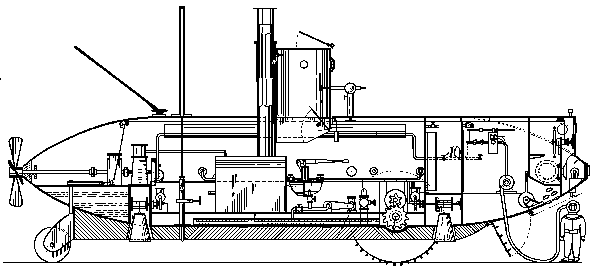

| Length | 36 feet 0 inches |
| Beam | 9 feet 0 inches |
| Displacement | 59 tons |
The Argonaut I or Argonaut First as Simon Lake preferred to call her was built alongside John Holland's Plunger in Baltimore, Maryland and launched in 1897. The Argonaut I was a truly unique craft.
The Argonaut I was a bottom crawler rather than a true submarine. When on the surface, she was propelled by a traditional propeller, but when submerged, she crawled along the bottom using two forward mounted toothed wheels and a smaller stern mounted wheel that could be steered. She was powered by a 30 h.p. gas engine on the surface and submerged. When submerged, air was drawn in though a canvas hose connected to a floating buoy (the first configuration) or a long tube (the second configuration).1
A typical diving evolution began by bringing the vessel to a stop and lowering two anchors to the bottom. Once the anchors were down, the ballast tanks were filled until the deck was awash. Then the anchor chain was hauled in, drawing the Argonaut to the bottom. Once on the bottom, additional water was added to the ballast tanks in order to hold the vessel on the bottom and the anchors were pulled into their recesses.2 The Argonaut could then be driven around the bottom of the bay much like a "horseless carriage".
The Argonaut I was not a warship. She carried no weapons. Instead, she was fitted with a lock-out chamber for hard hat divers. The chamber was four feet long, capable of being presurized and had a hatch in the bottom. Simon lake startled many a visitor by submerging the submarine and opening this hatch to display the bottom of the bay or river.3
Inspite of surviving many storms, Simon Lake was not satisfied with the seakeeping characteristics of his vessel. In 1899, the Argonaut I underwent extensive modifications at the Robbins Dry Dock Company in Brooklyn during which a yacht-like superstructure was added. This superstructure nearly doubled the length of the boat. The remodelled vessel was renamed Argonaut II.4
Ó2000,2001, 2002 Gary McCue
Gary W. McCue
gwmccue@ct.metrocast.net
http://www.geocities.com/gwmccue